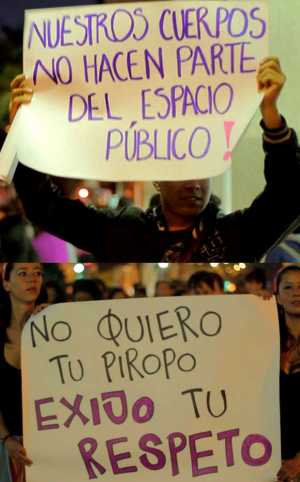From a very young age, women go through situations of harassment on the streets and in public or private spaces. Many accepted this as a fact, somehow it was never confronted.
Things are shifting

However, since the beginning of the 2000’s more groups willing to fight against this form of violence are surfacing. Currently, Peru, Chile, Colombia and Brazil already have initiatives calling for an end to the compliments and sexual harassment in public spaces.
The OCOC (Observatorio Contra El Acoso Callejero) was created with the help of groups of Peru and Chile. The group is formed by a sociologist, an educator, a psychologist, a philosophy, a social worker and director of film and TV.
The goal of the OCOC is to conduct debates in public places in order to explain how this obstruction on the streets is a type of violence.
Speaking out loud about harassment
Street harassment impacts most women at some point in their life. In order to deal with this problem we need to speak up, to let go of fear, to work as a team and take actions into our hands. So, let’s break this problem down. Street harassment usually begins when women are young.
If you have to walk near a construction site, hunch your back, mess up your hair, try to look as ugly as possible, that’s the only way they won’t say anything to you.
Most women and some men will face street harassment. Why? They think they have the right to do so but this couldn’t be farther from the truth. Street harassment limits people. It is a form of gender violence and it needs to stop.
Why do we have to put up with unwanted comments, gestures, and actions? These actions reveal gender power relations.
Harassers and assailants disrespect intimidate and insult women by evaluating their looks, telling them to smile, and making sexual demands of them, following and touching them. And yes, in extreme cases, assaulting and killing them.

Street harassment
While the prevalence of street harassment may be “new” to many men who read or hear about it, it’s not to women. Sadly enough, for generations, grandmothers, mothers, aunts, and older sisters have passed on tips and advice to girls to try to keep them safe.

But it’s time to go beyond that well-intentioned advice which makes women feel less safe and often doesn’t work. Street harassment is something that happens in almost any corner and those tips have the effect of limiting women’s access to public spaces. Actually, what happens is that women are on guard, off the streets, and dependent on men as escorts.
No country has ever achieved equality and no country will until women have the possibility to walk around without experiencing or fearing street harassment. Why should we depend on a man to feel safe? Why is it that we have to cover ourselves up in order to feel safe? Why do I have to pretend not to care?
Street harassment includes unwanted whistling, leering, sexist, and homophobic or transphobic slurs, persistent requests for someone’s name, number or destination after they’ve said no, sexual names, comments and demands, following, flashing, public masturbation, groping, sexual assault, and rape.
The Steps towards Change
Let me be crystal clear, street harassment is not a compliment, a minor annoyance, or a woman’s fault. And this is extremely important to acknowledge because someone’s ignorance or power trip does not give them the right to make us (women) feel like object or property.
It is a hounding behavior. As if we were apray, a prize. More often than not, teenage girls and young women hear these repulsive and gross comments. I can only imagine that whoever speak this ill-intentioned words thinks they are too young to know what to do or how to respond. Sadly, the harassers are correct.
“My body, my rules, my decision.” – Laura Viera A. –
The best and only way to counter attack is by empowering girls and women everywhere; teaching them self-defense tactics, to have assertive responses and how to report herrasers. Because as we all know, ignoring and avoiding harassers changes nothing.
Another way to help is to focus on potential and current harassers. We have to stop looking the other way or saying “boys will act like boys”. I ask myself: how would a herrasers react when someone herrasers their mothers, girlfriends or daughters?

Let me be clear: a person has the right to access porn, and phantasies of whatever situation he or she may want, but they do not have the right to take out those phantasies into the streets and act as if our bodies belong to them.
Things will change in time, I know this. Thanks to places like the Observatorio Contra el Acoso Callejero (Colombia) people are starting to confront themselves with this problem.
We need to change the society that lets street harassment occur. Our job is simple: We must challenge all comments, forms of media, and policies that disrespect and discriminate against women.
We must challenge all gender-based violence, provocations and harassment; it’s all connected.
Ever notice how dudes run shirtless all the time and nobody hollers sexual comments at them? If you haven’t, it’s probably because you’re a dude who has the privilege of not being harassed on the street. If you care about the current and next generation of girls, if you support equality, if you believe in human decency, then don’t sit by. Do something. Harassment is about power and control and it is often a manifestation of societal discrimination.


